Terrariums offer an enchanting way to bring miniature ecosystems into your living space, combining artistry with horticulture in stunning glass containers. These self-contained gardens have evolved far beyond simple plant displays, becoming sophisticated design statements that transform any room. Whether you prefer lush tropical environments, minimalist desert landscapes, or whimsical fairy tale scenes, terrarium design provides endless creative possibilities. Each style creates a unique atmosphere while requiring minimal maintenance, making them perfect for both experienced gardeners and beginners. From hanging installations to tabletop centerpieces, modern terrarium designs blend natural beauty with contemporary aesthetics, creating captivating focal points that celebrate the wonder of plant life in innovative, space-saving formats.
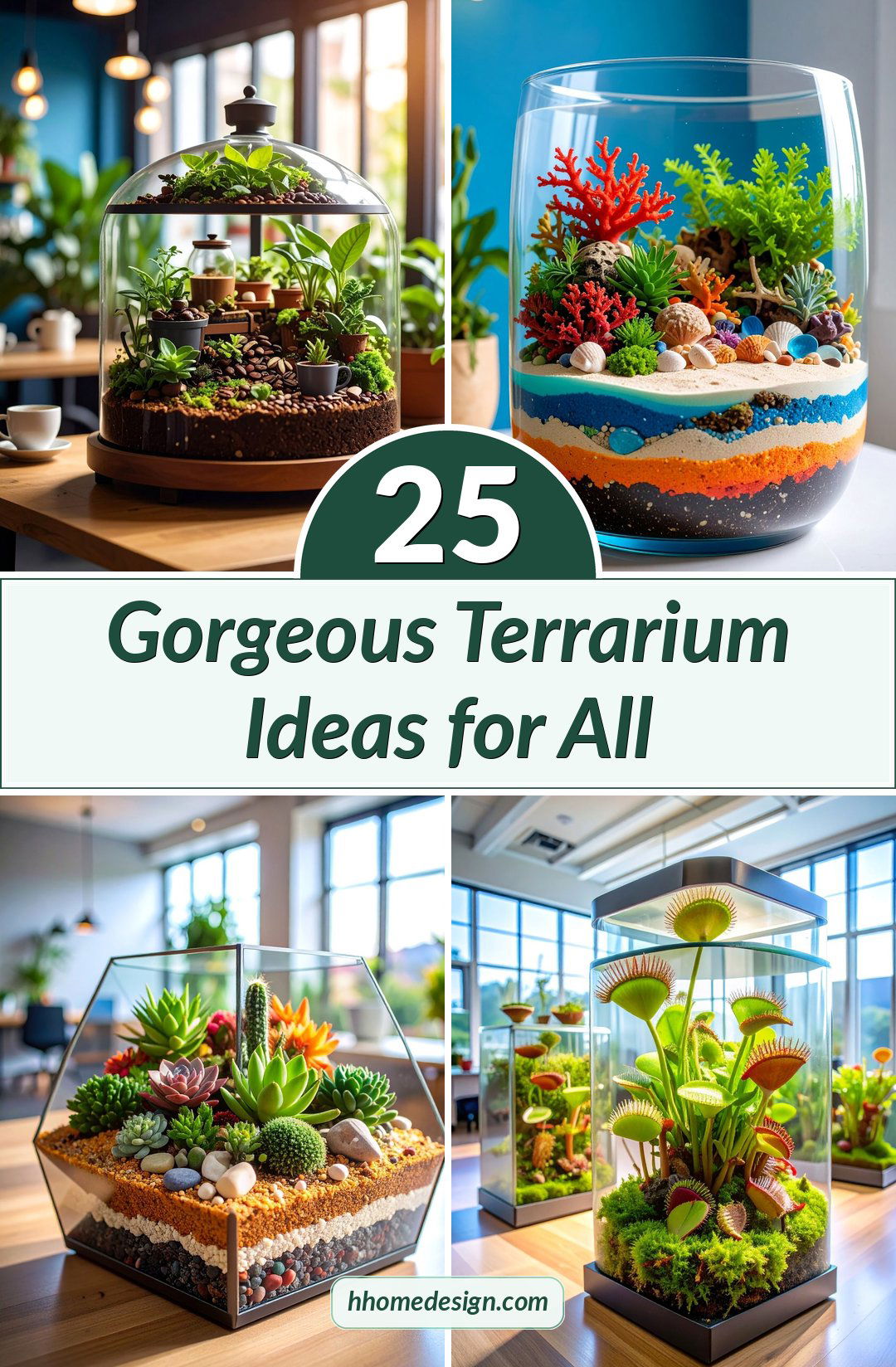
1. Hanging Globe Air Plant Terrarium
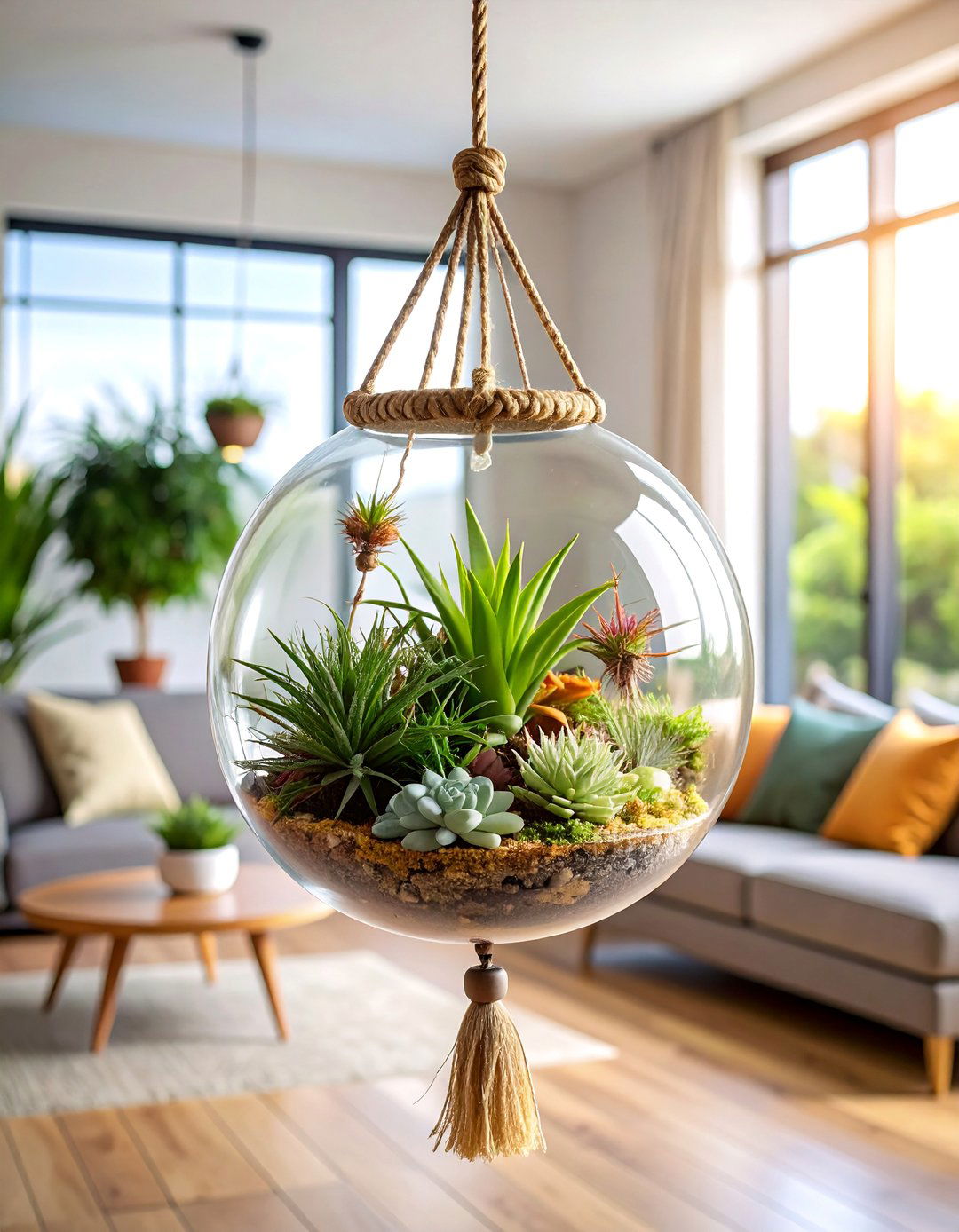
Air plants suspended in spherical glass containers create mesmerizing floating garden displays that require zero soil and minimal maintenance. These Tillandsia species thrive on air circulation and occasional misting, making them perfect for busy lifestyles. The transparent globe showcases the plant's unique sculptural forms while allowing light to filter through from all angles. Enhance the design with decorative elements like sea glass, driftwood pieces, or colorful sand layers that complement your interior palette. Position these hanging gardens near windows where indirect sunlight bathes the plants, creating dynamic shadows and highlighting their silvery-green textures. The three-dimensional aspect adds depth to any room while maintaining an airy, uncluttered aesthetic that suits modern and bohemian spaces equally well.
2. Geometric Succulent Desert Terrarium

Combine angular glass containers with drought-tolerant succulents to create striking contemporary desert landscapes that celebrate minimalist design principles. These open terrariums feature carefully layered colored sands, small pebbles, and precisely arranged cacti species like Echeveria, Haworthia, and tiny barrel cacti. The geometric container shapes—triangular, hexagonal, or diamond-cut—provide clean architectural lines that complement modern furniture and décor. Strategic placement of decorative stones and driftwood pieces creates natural-looking rock formations within the miniature desert environment. These low-maintenance gardens require infrequent watering and thrive in bright, indirect light conditions. The contrast between the sharp container edges and organic plant forms creates visual tension that draws the eye while maintaining sophisticated simplicity throughout the composition.
3. Closed Tropical Rainforest Terrarium

Transform sealed glass containers into lush tropical microclimates featuring moisture-loving ferns, mosses, and miniature palm varieties that recreate authentic rainforest atmospheres. These self-sustaining ecosystems maintain perfect humidity levels through natural water cycling, requiring minimal intervention once established. Layer Cushion moss, Maidenhair ferns, and small Parlor palms alongside decorative elements like smooth river rocks and preserved wood branches. The enclosed environment creates a greenhouse effect that supports tropical plants while generating gentle condensation patterns on the glass walls. This living diorama brings exotic beauty indoors without the need for constant humidity monitoring. Position these terrariums away from direct sunlight to prevent overheating while ensuring adequate ambient light for photosynthesis and healthy plant development.
4. Fairy Garden Miniature Village Terrarium

Create enchanting storytelling environments by combining tiny plants with whimsical miniature houses, bridges, and fairy figurines that spark imagination and wonder. These magical landscapes feature small ferns, moss patches, and delicate flowering plants arranged around hand-painted resin cottages and tiny garden accessories. Incorporate winding pathways made from colored sand or small pebbles leading to miniature doors and windows that suggest hidden fairy residents. Battery-operated LED lights can illuminate tiny lanterns and create twilight magic effects. Choose plants like Baby's Tears, small hostas, and creeping thyme that maintain appropriate scale while providing lush greenery. These charming displays appeal to children and adults alike, serving as conversation starters while bringing fantasy elements into everyday living spaces through careful attention to proportion and storytelling detail.
5. Wall-Mounted Vertical Garden Terrarium
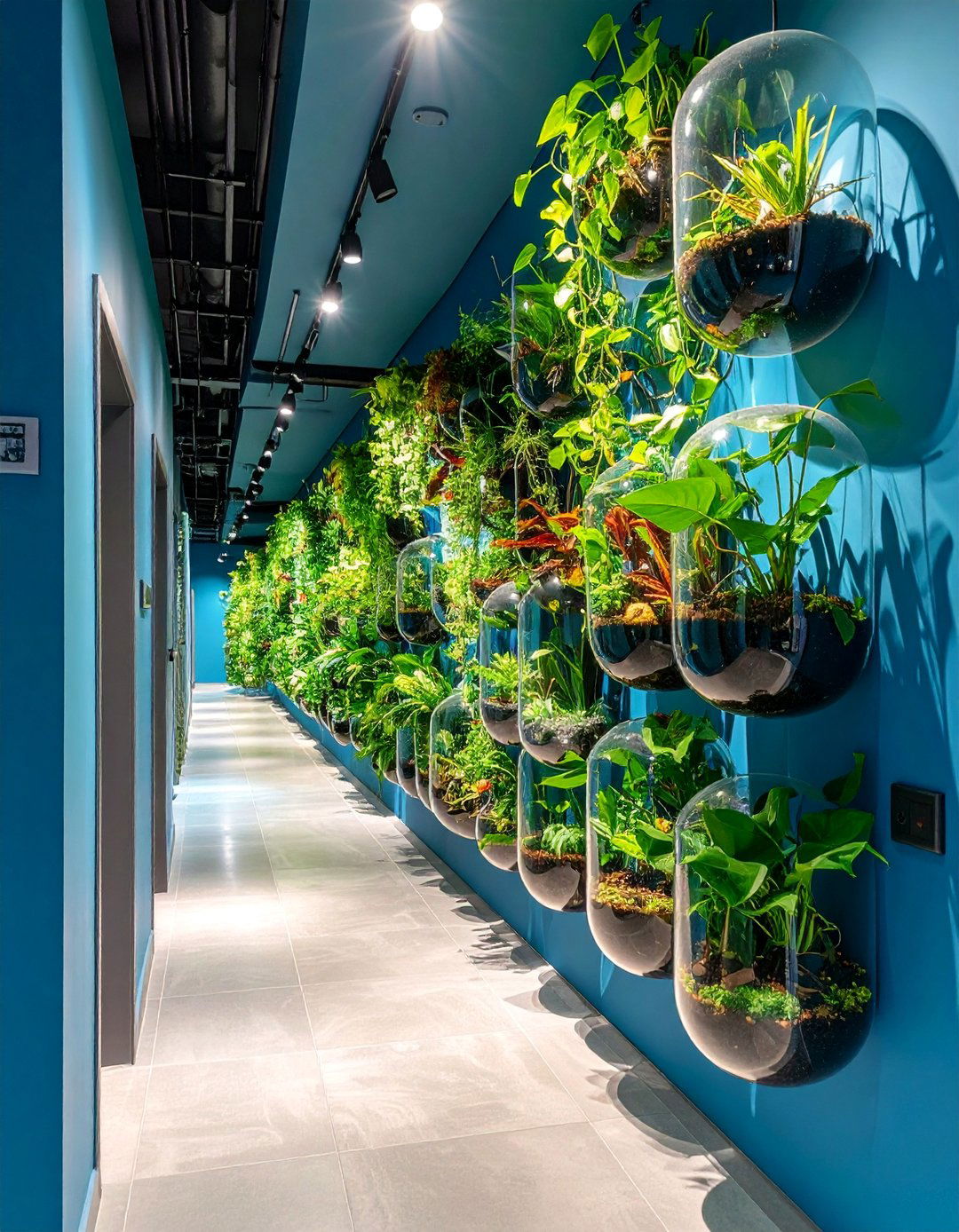
Install floating glass containers on wall surfaces to create living art installations that maximize growing space while adding natural beauty to vertical surfaces. These space-saving designs feature specially designed mounting systems that securely hold various container shapes—from half-circles to rectangular boxes—against walls or room dividers. Plant selections include trailing species like Pothos, String of Hearts, and cascading succulents that create dramatic vertical flowing effects. The three-dimensional wall garden becomes a dynamic focal point that changes with plant growth and seasonal variations. Strategic lighting enhances the display during evening hours while highlighting the interplay between shadows and plant forms. These installations work particularly well in small apartments, offices, or narrow hallways where floor space is limited but wall area offers creative opportunities.
6. Moss Landscape Zen Terrarium
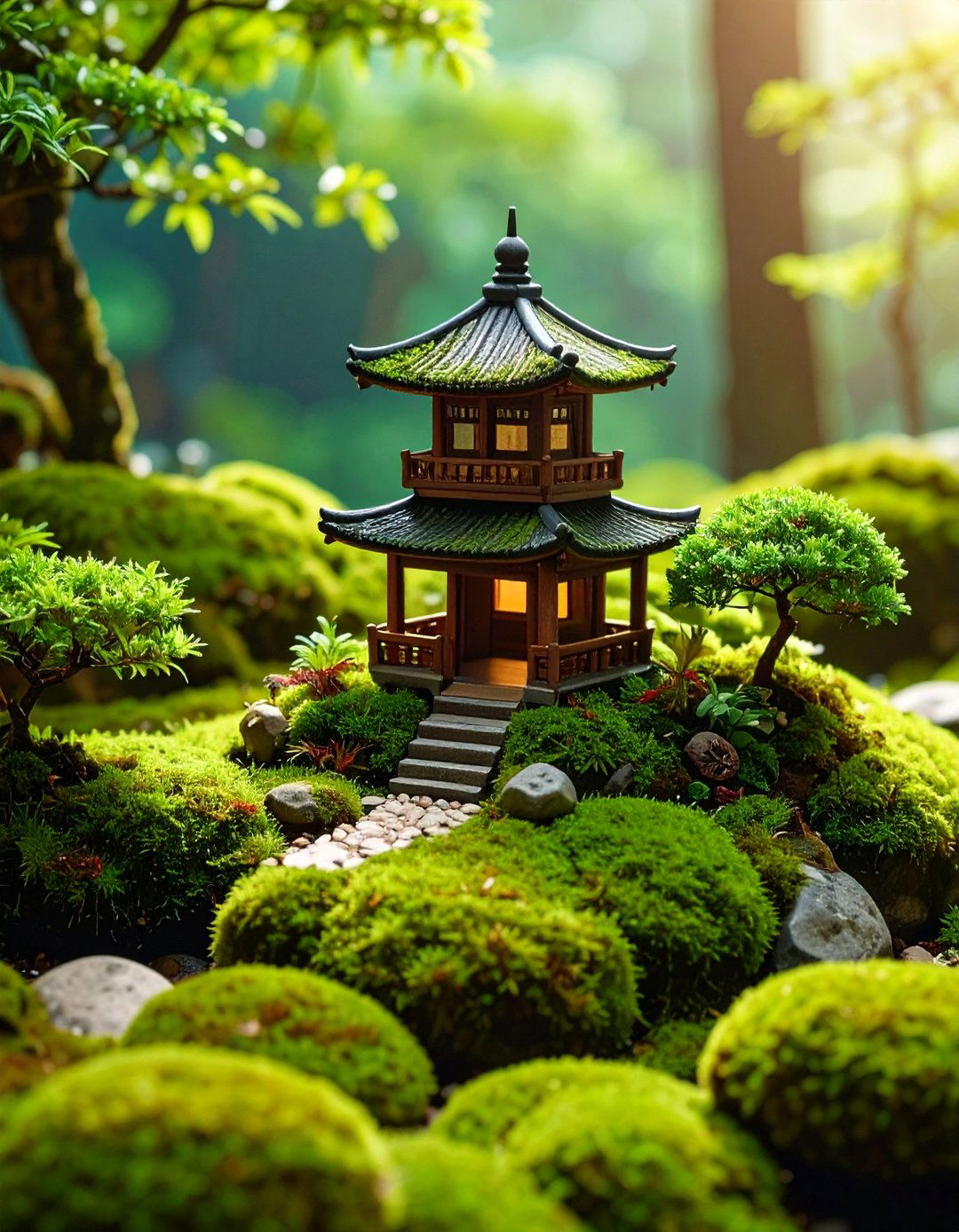
Design peaceful meditation spaces using various moss species arranged in harmonious compositions that evoke Japanese garden aesthetics and promote tranquil contemplation. These serene displays feature different moss textures—from velvety Cushion moss to delicate Sheet moss—creating rolling hills and valleys within contained glass environments. Incorporate smooth stones, small pieces of driftwood, and perhaps a single striking element like a miniature stone pagoda or Buddha figurine to enhance the zen atmosphere. The predominantly green color palette with subtle textural variations creates calming visual experiences that reduce stress and promote mindfulness. These living landscapes require consistent moisture levels and indirect lighting to maintain their lush appearance. The simple, uncluttered design philosophy emphasizes natural beauty while creating spaces for quiet reflection and mental restoration through nature connection.
7. Beachscape Sand Art Terrarium
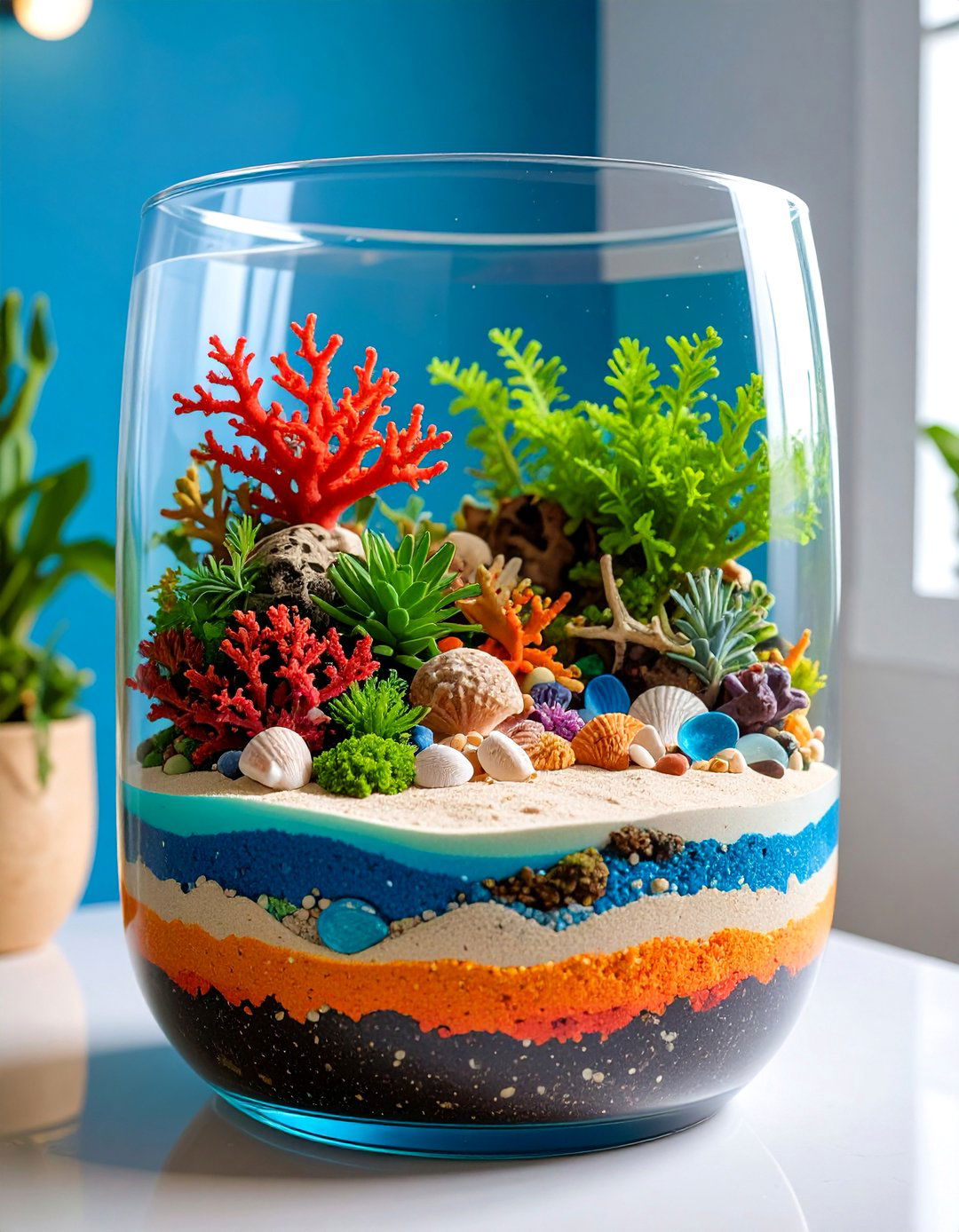
Capture coastal serenity by layering different colored sands with beach-themed plants and decorative elements that evoke seaside memories and vacation atmospheres. These nautical-inspired designs feature air plants, small succulents, and salt-tolerant species arranged among coral pieces, seashells, and sea glass fragments. Create depth through strategic sand layering in blues, whites, and natural tones that mimic ocean waves and sandy shores. Incorporate driftwood pieces that serve as natural sculpture elements while providing mounting surfaces for epiphytic plants. These terrariums work beautifully in bathrooms, sunrooms, or any space where you want to create relaxing coastal vibes. The color palette and natural materials connect inhabitants to ocean environments while requiring minimal maintenance beyond occasional misting and positioning in bright, indirect light locations.
8. Vintage Apothecary Jar Herb Terrarium
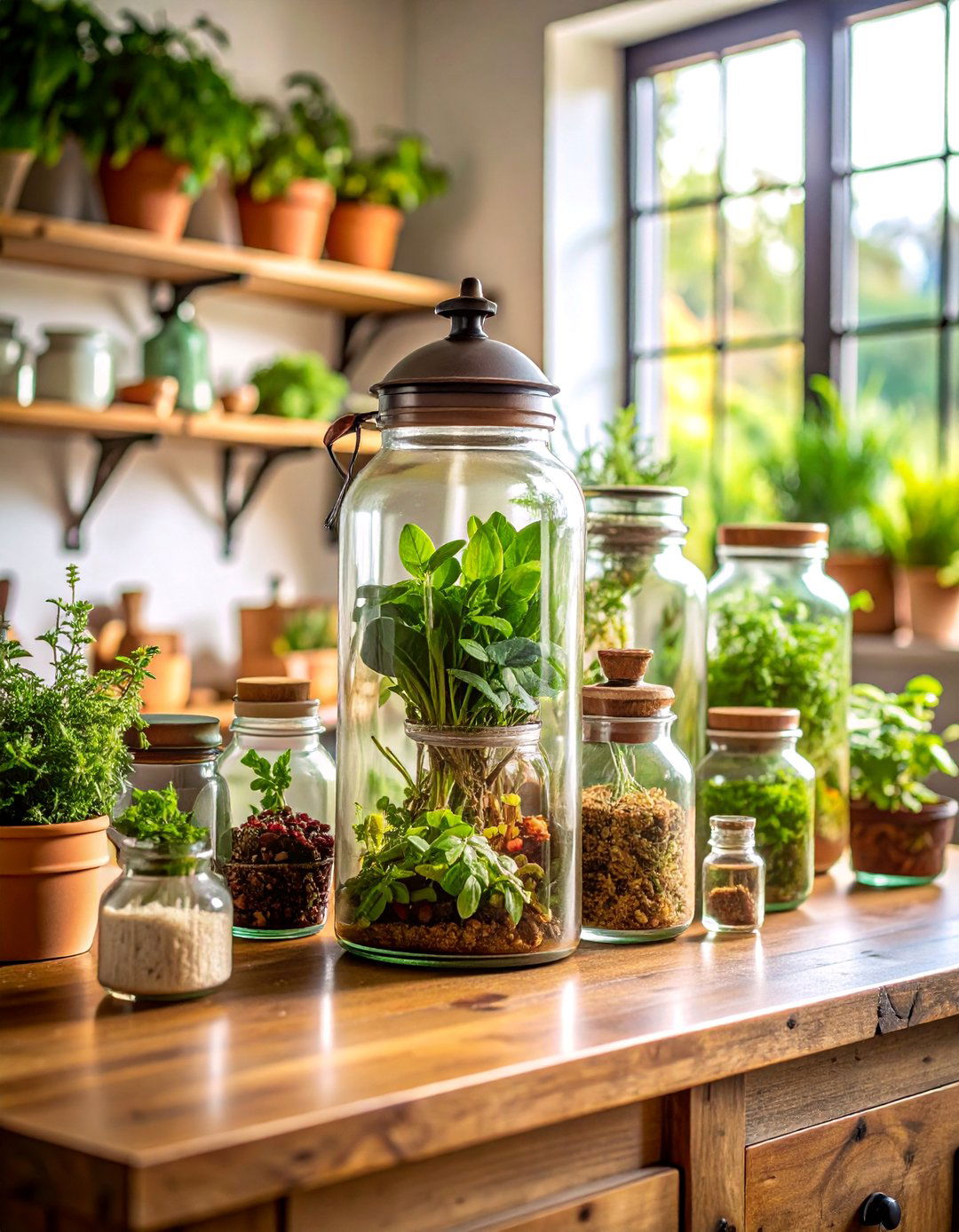
Repurpose antique glass jars or vintage-style containers to create functional herb gardens that combine historical charm with practical culinary growing capabilities. These nostalgic designs feature small herb varieties like thyme, oregano, and miniature basil plants arranged in old-fashioned mason jars or reproduction apothecary vessels. Layer the growing medium with activated charcoal, pebbles, and quality potting soil to ensure proper drainage and plant health. Hand-written labels or vintage-style tags add authentic touches while identifying different herb varieties for cooking use. These containers work well clustered on kitchen windowsills or dining room surfaces where natural light supports healthy growth. The combination of functional growing space and decorative appeal makes these terrariums both beautiful and useful additions to herb-loving households seeking unique growing solutions.
9. Carnivorous Plant Bog Terrarium
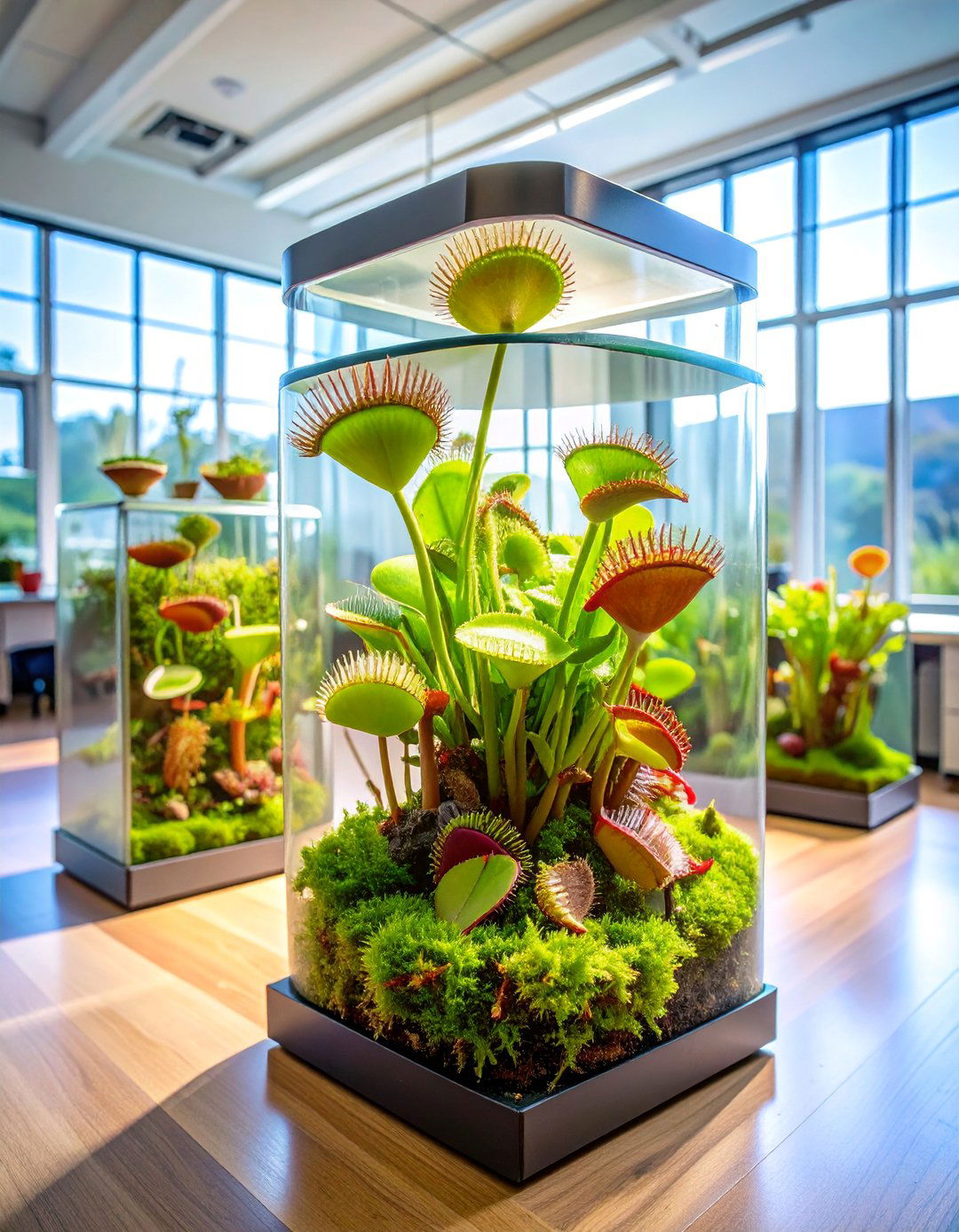
Create fascinating educational displays featuring Venus flytraps, pitcher plants, and sundews in specialized bog environments that demonstrate nature's incredible adaptability and predatory mechanisms. These unique ecosystems require specific growing conditions including distilled water, sphagnum moss substrate, and carefully controlled humidity levels to replicate natural bog environments. The sealed container maintains consistent moisture while allowing observation of the plants' remarkable feeding behaviors and adaptations. Incorporate pieces of bog wood and additional moss species to create authentic wetland aesthetics. These living science experiments captivate observers while teaching about specialized plant ecology and evolution. Position these terrariums in bright, indirect light locations where the unusual plant behaviors can be easily observed and appreciated. The combination of beauty and function makes these displays perfect for educational settings or curious nature enthusiasts.
10. Seasonal Winter Wonderland Terrarium
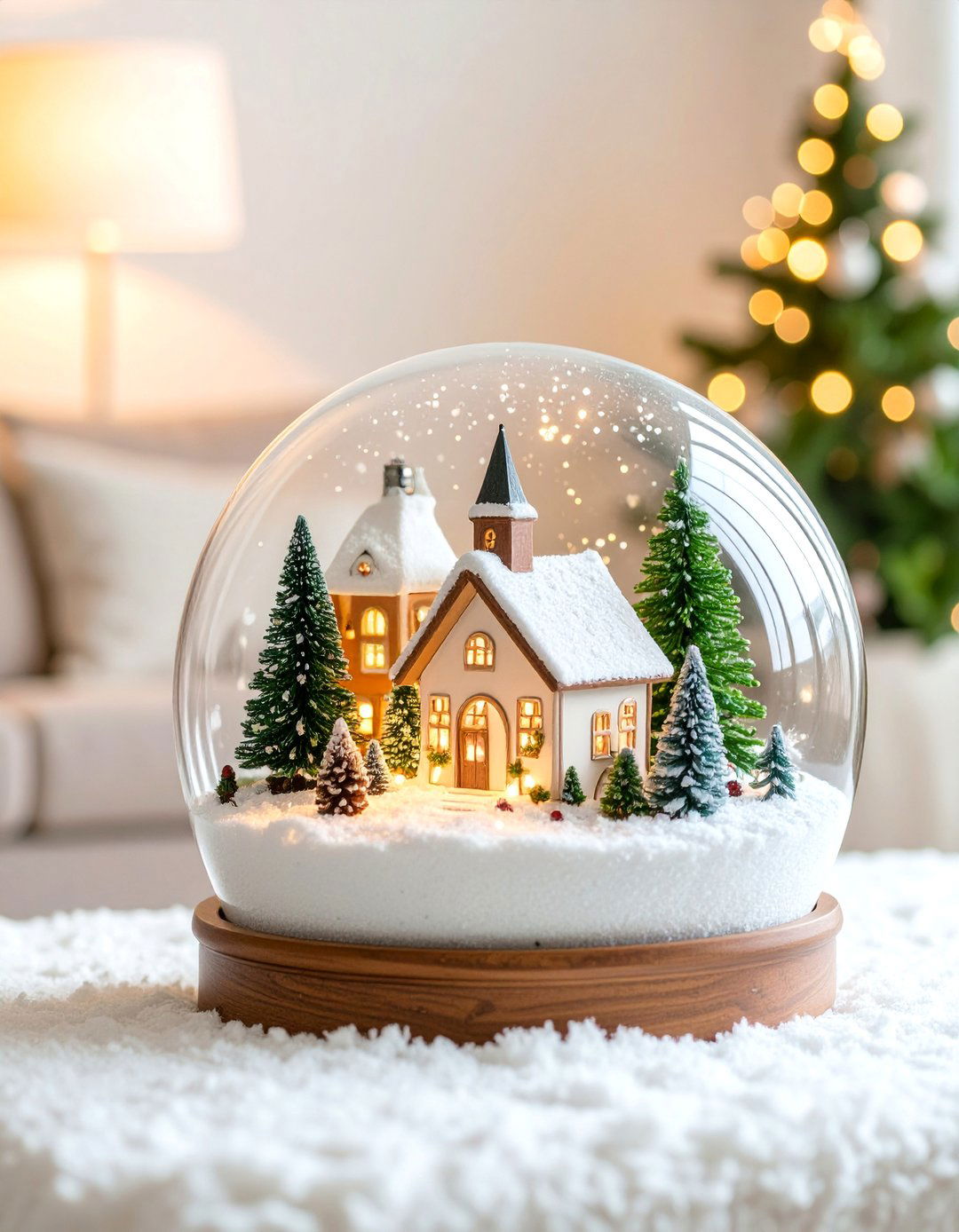
Design magical winter scenes using white and silver plants, artificial snow elements, and miniature winter decorations that capture the beauty of snowy landscapes year-round. These seasonal displays feature white-flowering plants, silvery succulents, and pale green mosses arranged among tiny pine trees, snow-covered village pieces, and sparkling decorative elements. Create depth through strategic placement of miniature snow-dusted accessories like tiny sleds, lamposts, or winter animals. The predominantly cool color palette with metallic accents creates sophisticated seasonal appeal that complements winter décor themes. Battery-operated micro LED lights can add twinkling effects that enhance the magical winter atmosphere during darker months. These displays bring seasonal joy indoors while providing living elements that connect inhabitants to nature's winter beauty through carefully curated plant selections and thematic accessories.
11. Orchid Greenhouse Micro Terrarium

Cultivate exotic miniature orchid varieties in carefully controlled glass environments that provide the high humidity and consistent conditions these delicate flowers require for optimal blooming. These sophisticated displays feature small orchid species like Jewel orchids or miniature Phalaenopsis arranged in specialized terrarium substrates that promote healthy root development. The enclosed environment maintains optimal humidity levels while preventing the air circulation problems that often plague orchid cultivation in home environments. Incorporate pieces of bark, moss, and decorative stones that support the orchids' epiphytic nature while creating visually appealing compositions. These elegant displays showcase the extraordinary beauty of orchid flowers while making these typically challenging plants accessible to home growers. Position these terrariums in bright, indirect light locations where the stunning blooms can be appreciated and the growing conditions monitored.
12. Bonsai Forest Miniature Landscape Terrarium

Create tiny woodland scenes featuring miniature bonsai trees, moss ground cover, and scenic elements that capture the essence of ancient forests in compact glass environments. These artistic displays combine traditional bonsai cultivation techniques with terrarium growing methods to produce living landscapes that evoke peaceful forest atmospheres. Small tree varieties like Ficus or Juniper species are carefully shaped and positioned among moss hills, tiny paths, and perhaps miniature meditation gardens or zen elements. The contrast between the detailed tree forms and supporting landscape elements creates dynamic compositions that change with tree growth and seasonal variations. These displays require careful attention to watering, pruning, and light conditions but reward caretakers with evolving living art that develops character over time. The meditative aspects of both bonsai care and terrarium maintenance combine to create therapeutic growing experiences.
13. Floating Crystal Garden Terrarium
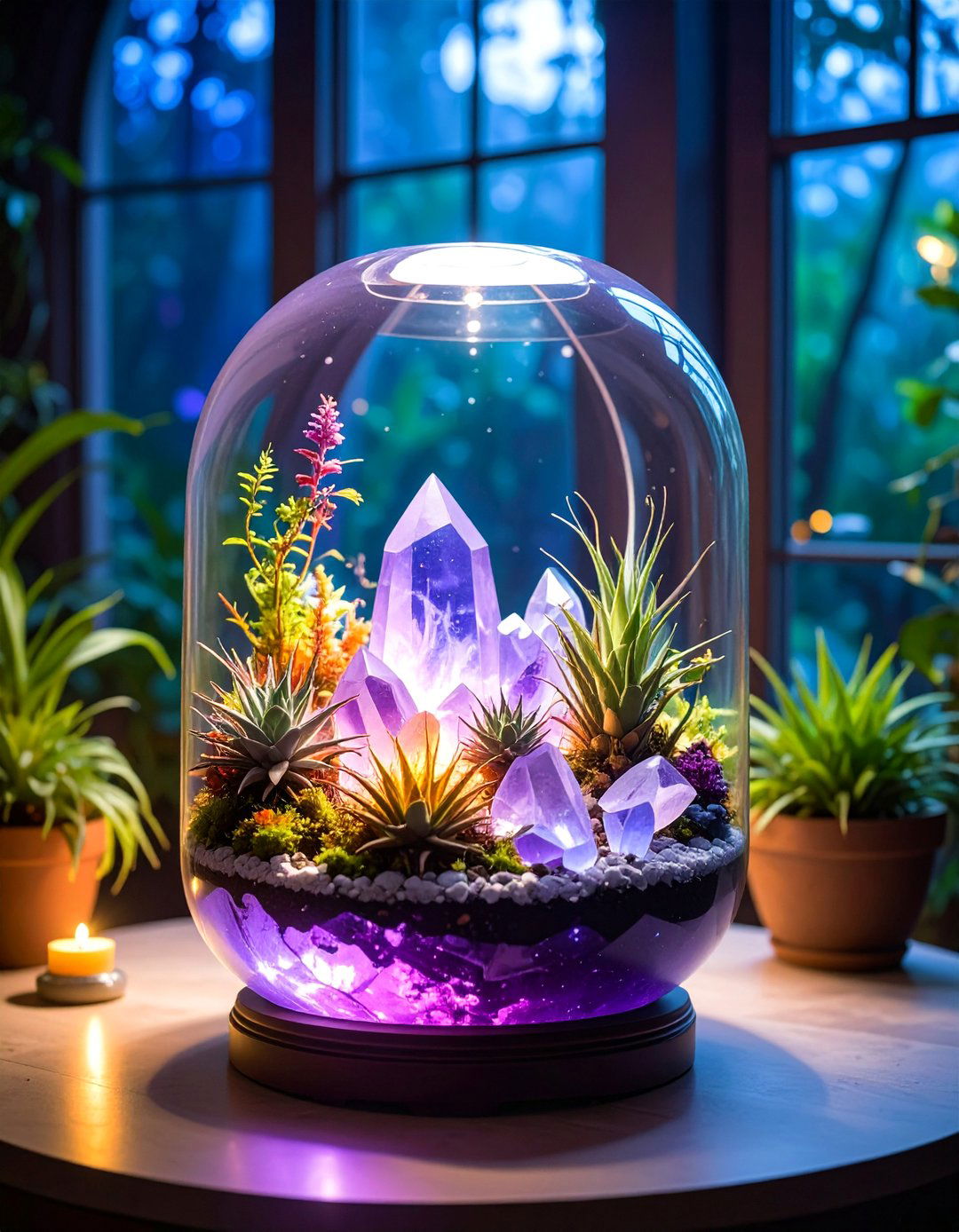
Combine air plants with crystal collections and geometric glass containers to create mystical displays that blend natural plant beauty with mineral aesthetics and metaphysical elements. These ethereal arrangements feature Tillandsia species mounted on or positioned near various crystals like amethyst, quartz, or rose quartz that complement the plants' silvery foliage. The combination of living plants and mineral specimens creates dynamic compositions that appeal to crystal enthusiasts and plant lovers alike. Strategic lighting enhances both the plant forms and crystal clarity while creating rainbow refractions that add magical elements to the display. These containers require minimal maintenance beyond occasional plant misting and crystal cleaning to maintain their luminous appearance. Position these terrariums where natural light can interact with both the crystals and plants to create ever-changing light displays throughout the day.
14. Succulent Rainbow Layer Terrarium

Design vibrant displays using colorful succulent varieties arranged in spectrum order alongside rainbow-colored sand layers that create joyful, uplifting compositions perfect for brightening any space. These cheerful arrangements feature succulents in various hues—from purple Echeveria to orange Kalanchoe to yellow Sedum—positioned above carefully layered colored sands that mirror the plant colors. The open container design allows the succulents to thrive while showcasing the rainbow stratification that serves as both growing medium and decorative element. These displays work particularly well in children's rooms, creative spaces, or anywhere that benefits from bright, optimistic color schemes. The low-maintenance nature of succulents combined with the enduring beauty of colored sand creates long-lasting displays that maintain their visual impact with minimal care. Strategic container positioning ensures adequate light while protecting the sand layers from disturbance.
15. Terrarium Water Feature Garden

Incorporate miniature water elements like small pumps, artificial streams, or water-filled sections within larger terrarium environments to create dynamic displays that combine aquatic and terrestrial growing zones. These sophisticated ecosystems feature both water-loving plants like small ferns and aquatic varieties alongside traditional terrarium plants in carefully designed multi-zone environments. The gentle sound of trickling water adds sensory appeal while creating humidity that benefits all the plants in the display. Small water pumps circulate water through carved channels or over decorative stone formations that mimic natural waterfalls or streams. These complex systems require careful planning and maintenance but create stunning focal points that bring the soothing sounds and visual appeal of water features into indoor spaces. The combination of multiple plant zones and water movement creates dynamic, ever-changing displays.
16. Gothic Dark Academia Terrarium
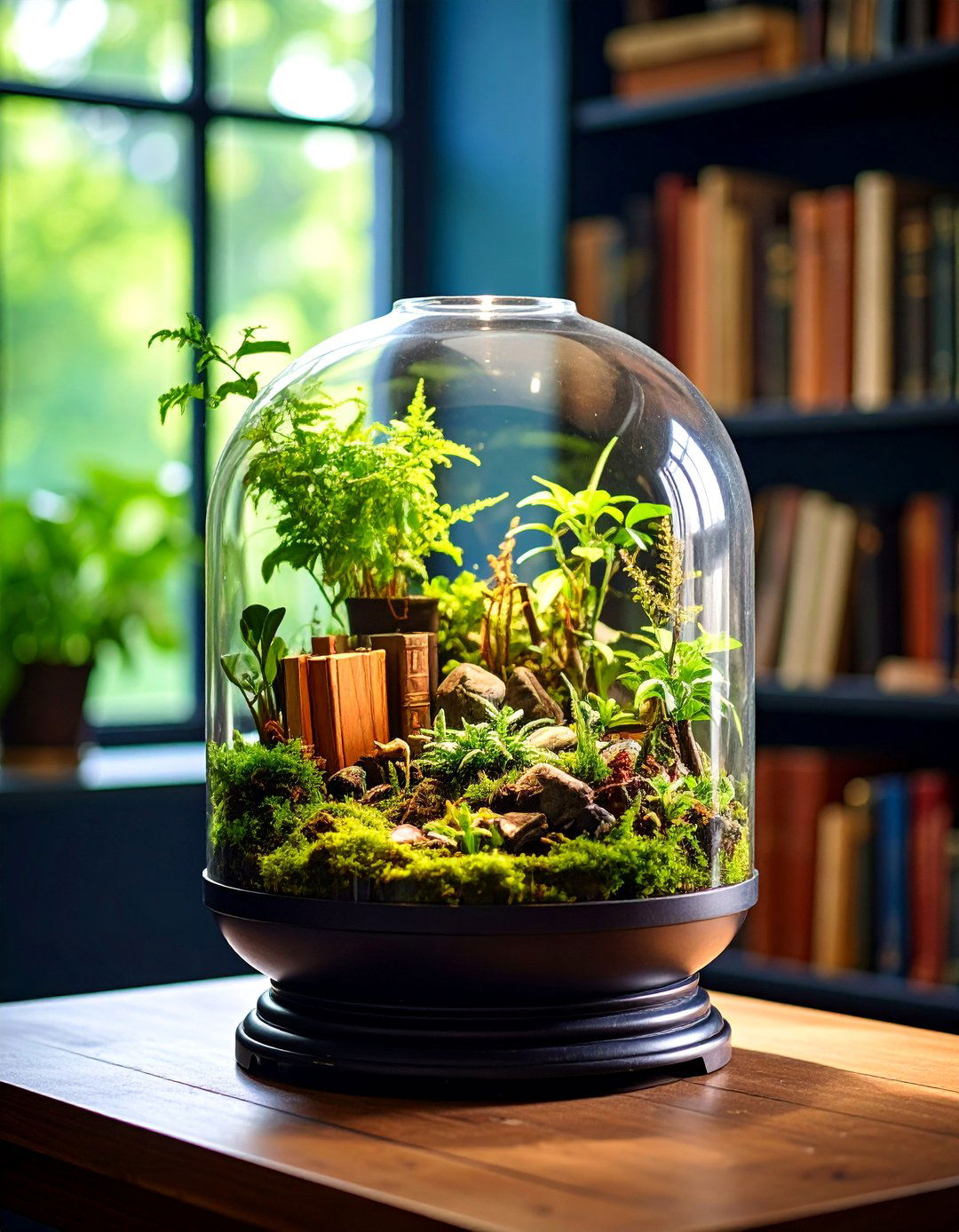
Create mysterious, scholarly atmospheres using dark containers, deep green plants, and vintage academic accessories that evoke gothic literature and classical learning environments. These sophisticated displays feature plants with dark foliage like black-leafed begonias, deep green ferns, and trailing ivy varieties arranged among miniature books, antique-style magnifying glasses, and dark decorative elements. The predominantly dark color palette with rich green accents creates dramatic compositions perfect for studies, libraries, or spaces with gothic or vintage décor themes. Incorporate elements like tiny skulls, vintage keys, or miniature laboratory equipment to enhance the academic atmosphere. These displays appeal to literature lovers, gothic enthusiasts, and anyone drawn to mysterious, intellectual aesthetics. The plant selections tolerate lower light conditions while maintaining their dramatic appearance in sophisticated container styles that complement traditional or vintage interior design schemes.
17. Coffee Bean Café Terrarium
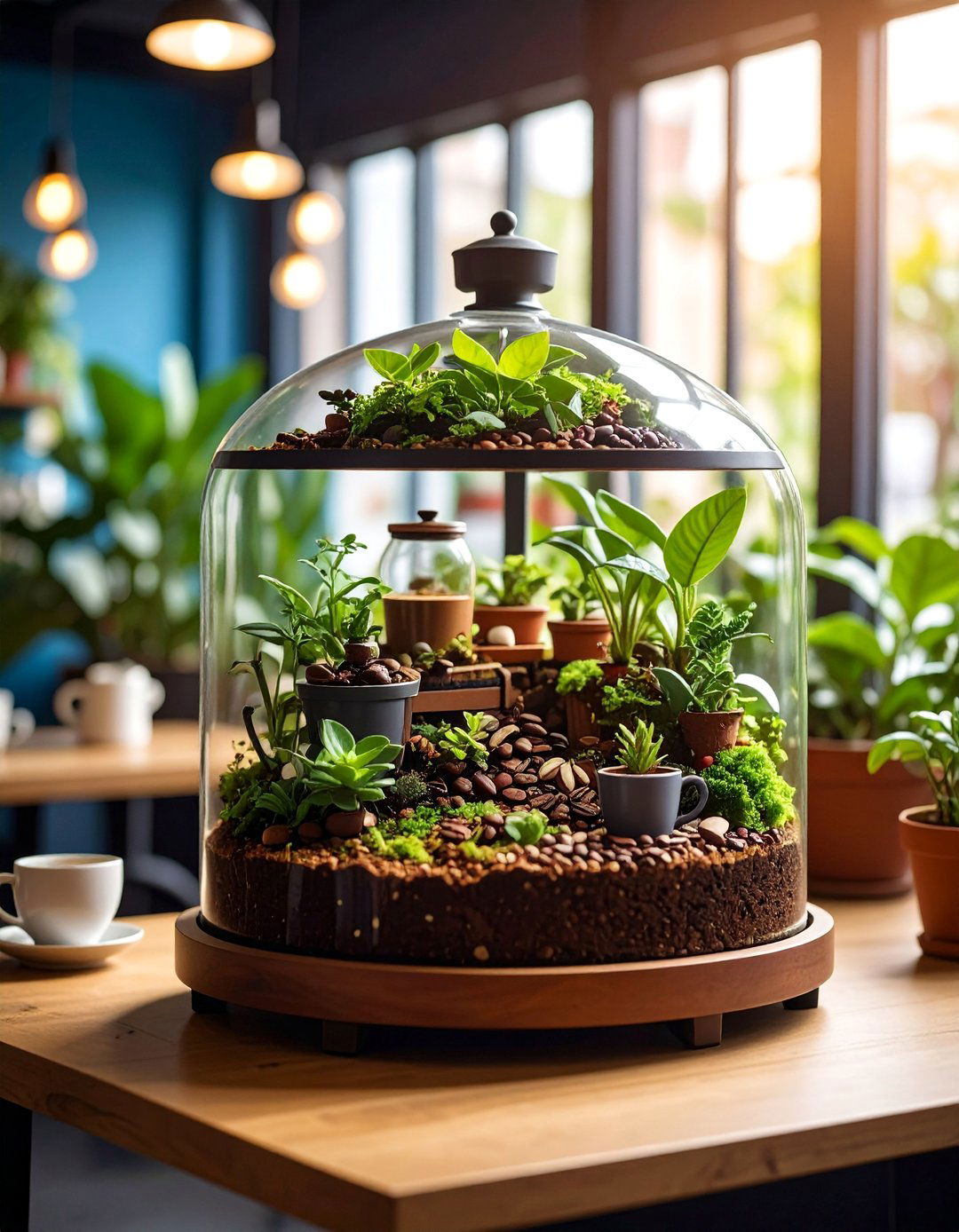
Design aromatic displays featuring small coffee plants, coffee bean decorations, and café-themed miniature accessories that celebrate coffee culture while providing actual growing coffee plants in compact formats. These thematic arrangements feature young coffee plants (Coffea arabica) arranged among scattered coffee beans, tiny café furniture, and miniature coffee-related decorations. The plants' glossy green leaves and potential for small white flowers create attractive displays that connect coffee enthusiasts to the agricultural origins of their favorite beverage. These terrariums work beautifully in kitchens, coffee nooks, or café-themed spaces where the aromatic plants can be appreciated. While the plants may not produce significant coffee harvests in terrarium conditions, they provide educational value and connection to coffee cultivation. The combination of living plants and thematic elements creates conversation pieces that appeal to coffee lovers while providing unique growing experiences.
18. Hobbiton Miniature Village Terrarium
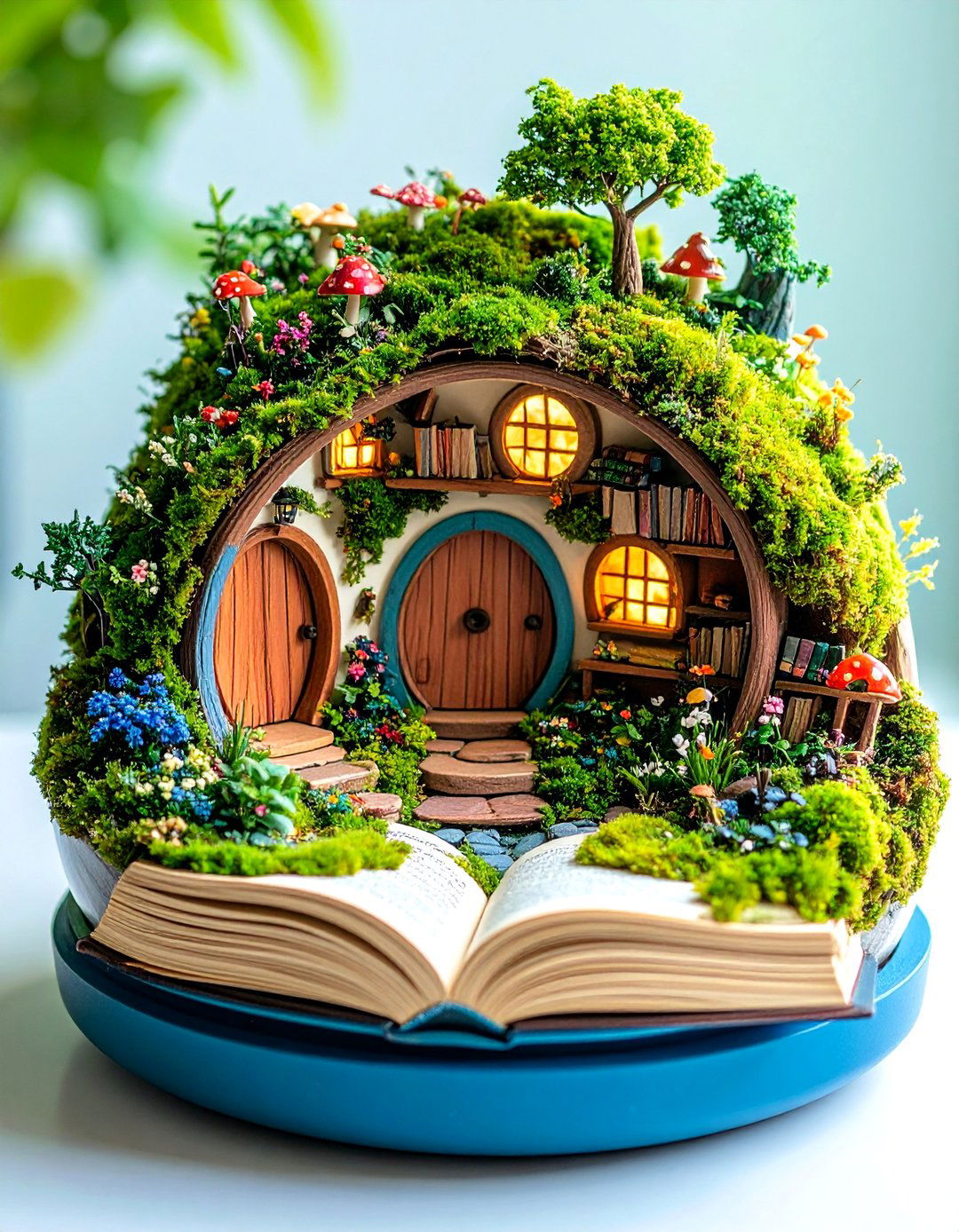
Create enchanting fantasy landscapes inspired by hobbit villages featuring tiny round doors, miniature gardens, and lush green plants that evoke the magical countryside of Middle-earth. These whimsical displays combine small mounding plants like moss and miniature hostas with hand-crafted hobbit holes built into artificial hills or container sides. Tiny garden accessories like miniature vegetables, flower patches, and winding paths create authentic village atmospheres that transport viewers into fantasy realms. The predominantly green color palette with earth-tone accents reflects the pastoral beauty of imagined hobbit communities. These displays appeal to fantasy enthusiasts and provide opportunities for creative storytelling through carefully arranged scenes. The combination of living plants and imaginative accessories creates displays that evolve over time as plants grow and change, maintaining the magical appeal while providing ongoing care activities that connect caretakers to the fantasy narrative.
19. Meditation Mandala Sand Terrarium
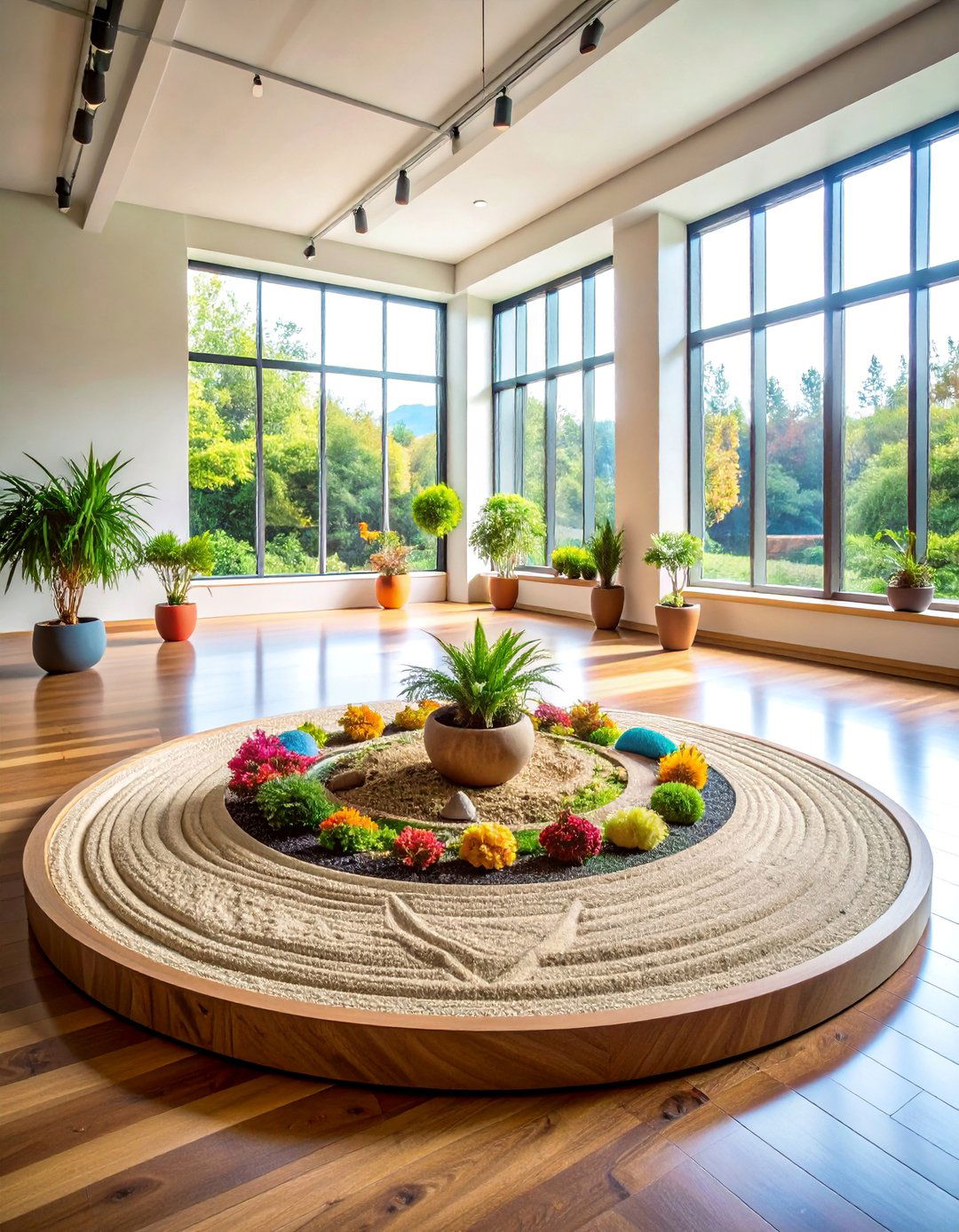
Design contemplative displays using colored sand arranged in mandala patterns surrounding central plant groupings that promote mindfulness and spiritual reflection through geometric beauty. These meditative arrangements feature carefully raked sand designs that incorporate traditional mandala symbols and patterns around central plantings of small succulents or air plants. The geometric sand patterns can be refreshed and redesigned as part of mindfulness practices, connecting caretakers to Buddhist and Hindu traditions while providing plant care activities. The combination of living plants and temporary sand art creates displays that balance permanence with impermanence, reflecting spiritual teachings about change and growth. These terrariums work well in meditation spaces, yoga rooms, or anywhere that benefits from peaceful, contemplative elements. The process of creating and maintaining both the plants and sand patterns provides therapeutic activities that promote stress reduction and mindful awareness.
20. Dinosaur Prehistoric Landscape Terrarium

Create educational prehistoric scenes featuring ferns, mosses, and other ancient plant species alongside miniature dinosaur figures that teach about paleobotany and prehistoric ecosystems. These thematic displays use plants that existed during dinosaur eras—like ferns, horsetails, and cycads—arranged in landscapes that evoke Mesozoic environments. Small dinosaur figures positioned throughout the display create educational opportunities while sparking imagination about prehistoric life. The plant selections reflect authentic prehistoric flora while thriving in modern terrarium conditions. These displays appeal to children and adults interested in paleontology while providing living examples of plant evolution. Incorporate elements like volcanic rock, petrified wood, or fossil replicas to enhance the prehistoric atmosphere. The combination of ancient plant species and dinosaur figures creates educational tools that make learning about prehistoric life engaging and tangible through hands-on plant care and imaginative play activities.
21. Micro Herb Kitchen Garden Terrarium

Develop functional culinary gardens featuring miniature herb varieties in accessible kitchen containers that provide fresh seasonings while serving as attractive countertop displays. These practical arrangements feature small-leafed herbs like micro basil, thyme, oregano, and chives planted in clear containers that allow root observation while maintaining easy access for harvesting. The living spice garden provides fresh ingredients for cooking while creating aromatic, attractive kitchen decorations. Strategic container placement near kitchen windows ensures adequate light for healthy herb growth while keeping plants accessible for daily use. These displays combine functionality with beauty, making herb gardening accessible to apartment dwellers and anyone with limited growing space. The satisfaction of growing and harvesting home-grown herbs enhances cooking experiences while connecting urban inhabitants to food production through small-scale, sustainable growing practices that fit seamlessly into modern kitchen environments.
22. Night-Blooming Moon Garden Terrarium
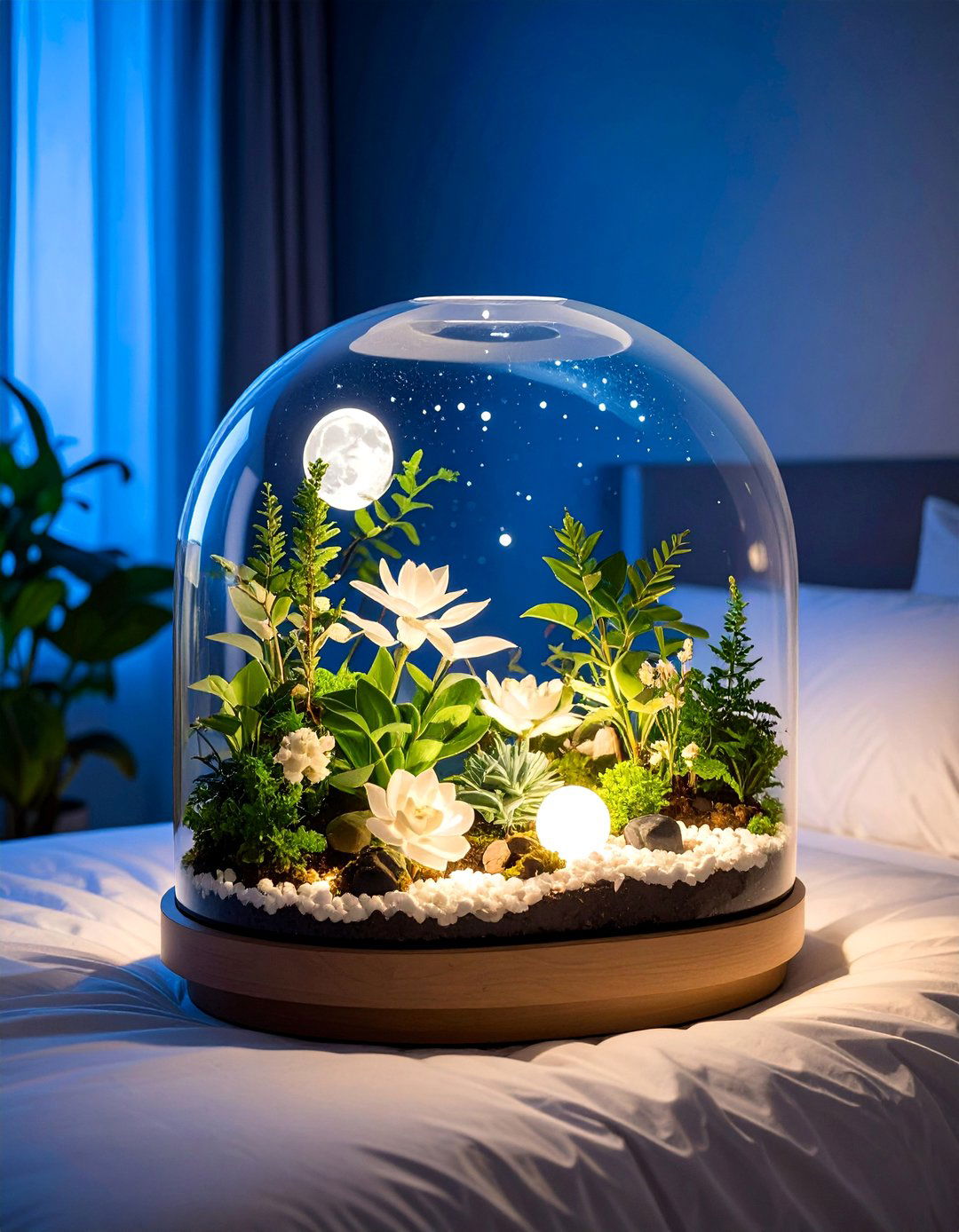
Create enchanting evening displays featuring white and silver plants alongside glow-in-the-dark elements and LED lighting that transform ordinary terrariums into magical nighttime landscapes. These sophisticated arrangements feature plants with white flowers, silver foliage, or pale green coloration that appears luminous under artificial lighting conditions. Incorporate glow-in-the-dark stones, phosphorescent decorative elements, and battery-operated LED systems that create ethereal lighting effects during darker hours. The predominantly pale color palette creates sophisticated displays that work well in bedrooms, meditation spaces, or anywhere that benefits from calming, moonlit atmospheres. These displays change character dramatically between day and night viewing, providing dual personalities that keep them interesting throughout daily cycles. The combination of living plants and lighting technology creates modern displays that blend natural beauty with contemporary innovation while promoting relaxation through gentle, soothing illumination patterns.
23. Steampunk Industrial Vintage Terrarium
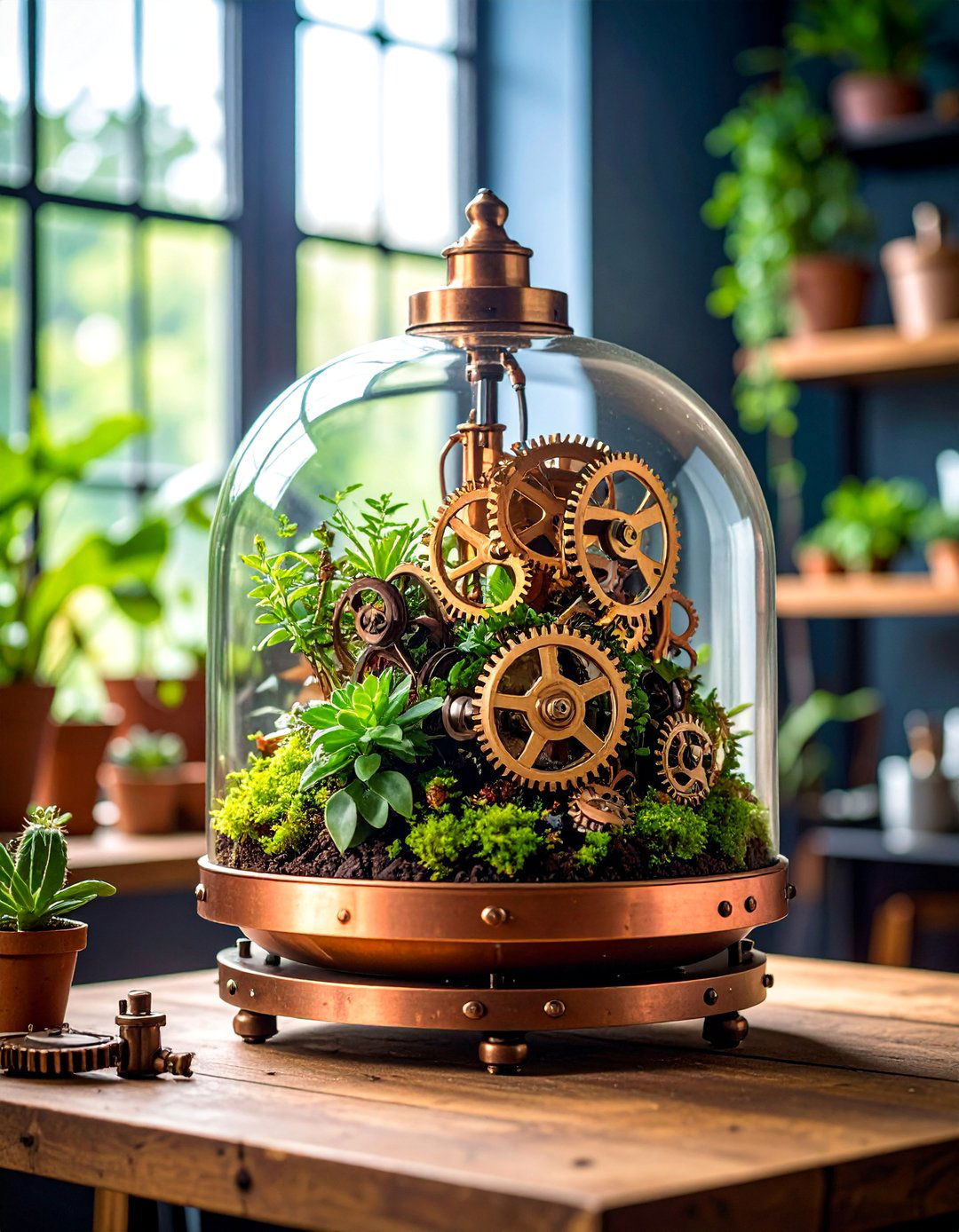
Design displays that blend living plants with vintage industrial elements like gears, copper pipes, and antique laboratory equipment to create unique steampunk-inspired growing environments. These creative arrangements feature hardy plants like succulents or air plants positioned among carefully selected vintage mechanical components that suggest alternative history or retro-futuristic themes. The combination of organic plant forms with metallic industrial elements creates dynamic visual contrasts that appeal to steampunk enthusiasts and vintage collectors. Incorporate elements like old pocket watches, brass fittings, or miniature steam gauges to enhance the industrial aesthetic while maintaining plant health through proper growing conditions. These displays work well in workshops, creative studios, or any space that benefits from unique, conversation-starting decorative elements. The marriage of natural growing systems with mechanical aesthetics creates thought-provoking displays that question the relationship between nature and technology.
24. Butterfly Garden Pollinator Paradise Terrarium
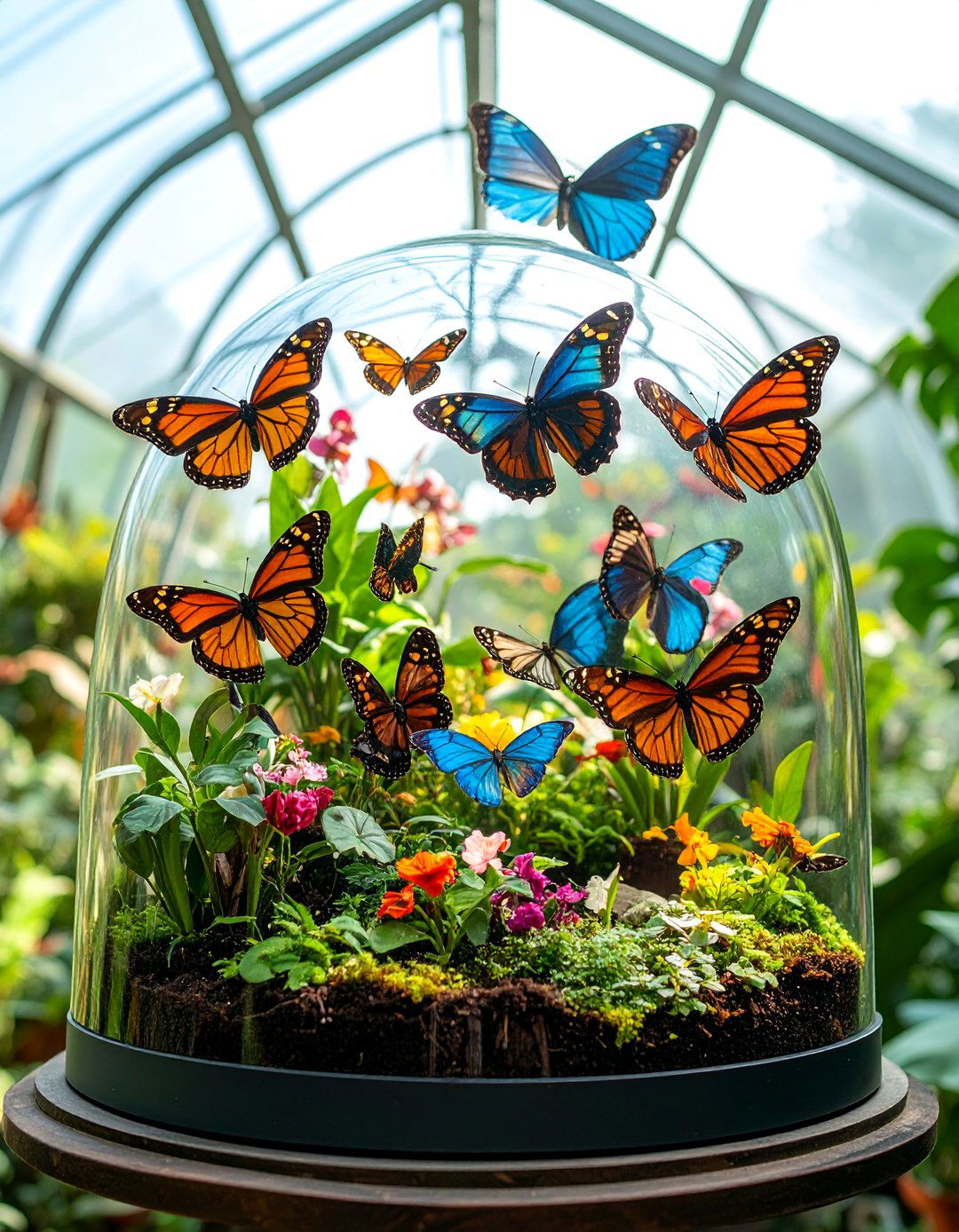
Create miniature ecosystems featuring flowering plants that attract beneficial insects alongside decorative butterfly elements that celebrate pollinator relationships and natural cycles. These educational displays feature small flowering varieties like miniature violets, tiny nasturtiums, or flowering herbs that provide nectar sources for beneficial insects while creating colorful, fragrant arrangements. Incorporate artificial butterfly decorations, bee figures, or other pollinator representations that highlight the important relationships between plants and insects. These displays serve as educational tools for teaching about pollination while providing actual pollinator habitat in urban environments. The flowering plants require careful attention to lighting and watering but reward caretakers with colorful blooms and potential visits from real pollinators. These arrangements work well in sunrooms, covered porches, or any bright location where both plants and beneficial insects can thrive while creating living classrooms about ecological relationships.
25. Aurora Borealis Color-Changing LED Terrarium

Design futuristic displays combining traditional plants with programmable LED lighting systems that cycle through aurora-like color patterns to create dynamic, ever-changing visual experiences. These high-tech arrangements feature plants selected for their response to colored lighting—species with interesting leaf textures or forms that change appearance under different colored illumination. The LED systems can be programmed to slowly shift through color spectrums that mimic northern lights displays, creating magical atmospheric effects that transform throughout viewing periods. These displays blend natural plant beauty with cutting-edge lighting technology to create modern art pieces that function as both living gardens and light sculptures. The plants thrive under the full-spectrum LED systems while providing organic contrast to the technological elements. These arrangements appeal to technology enthusiasts and anyone interested in exploring the intersection between natural systems and digital innovation through carefully designed growing environments that push terrarium design boundaries.
Conclusion:
These twenty-five terrarium ideas demonstrate the limitless creative possibilities available when combining plants, containers, and imagination. From simple hanging air plant displays to complex technological installations, each design approach offers unique opportunities for personal expression while connecting inhabitants to nature's beauty. Whether you prefer minimalist geometric arrangements or elaborate themed landscapes, terrarium gardening provides accessible pathways to indoor growing that accommodate any space, skill level, or aesthetic preference. The key lies in selecting designs that match your lifestyle, interests, and available care commitment. These miniature ecosystems continue evolving as plants grow and seasons change, providing ongoing satisfaction and connection to natural cycles within modern living environments.


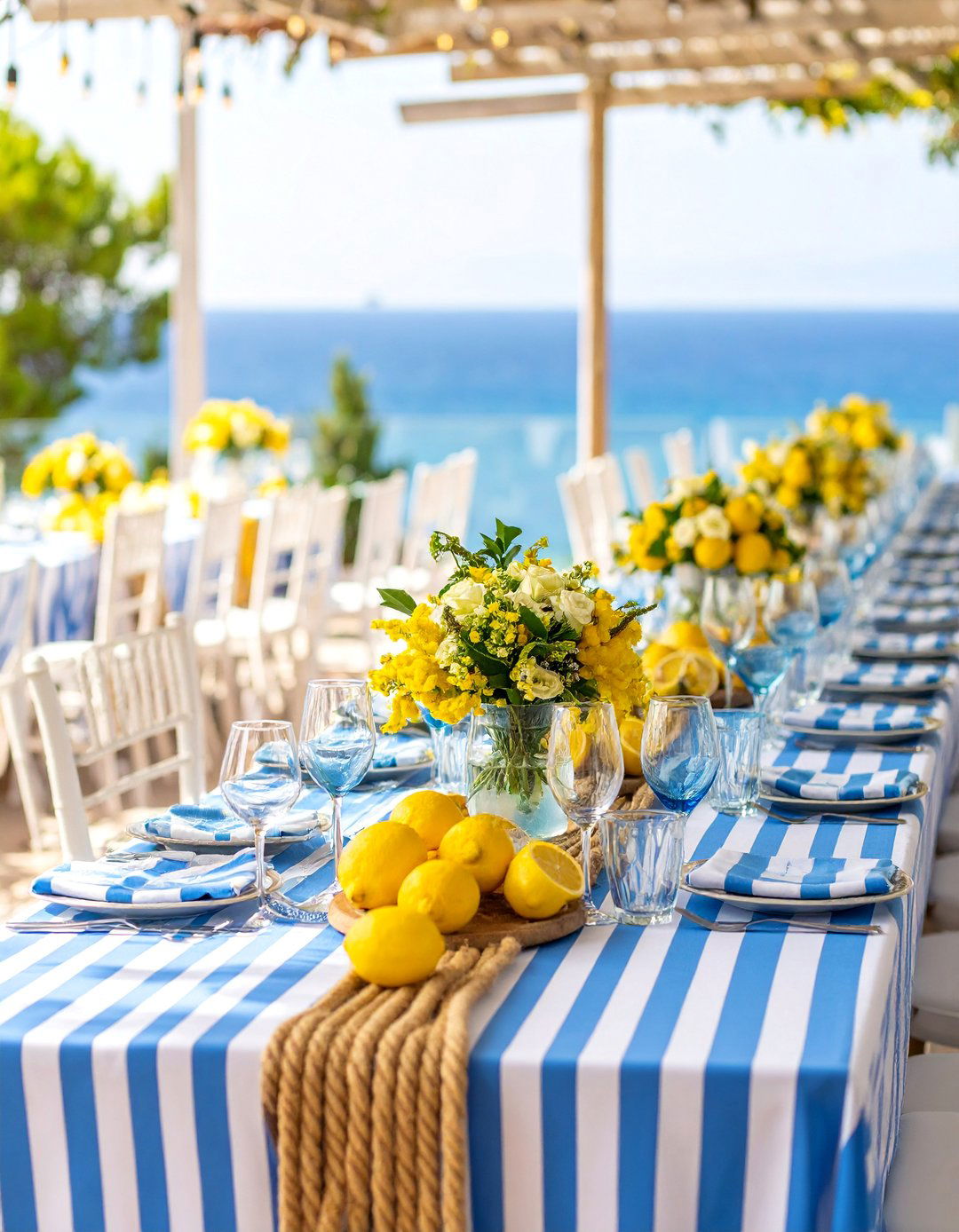
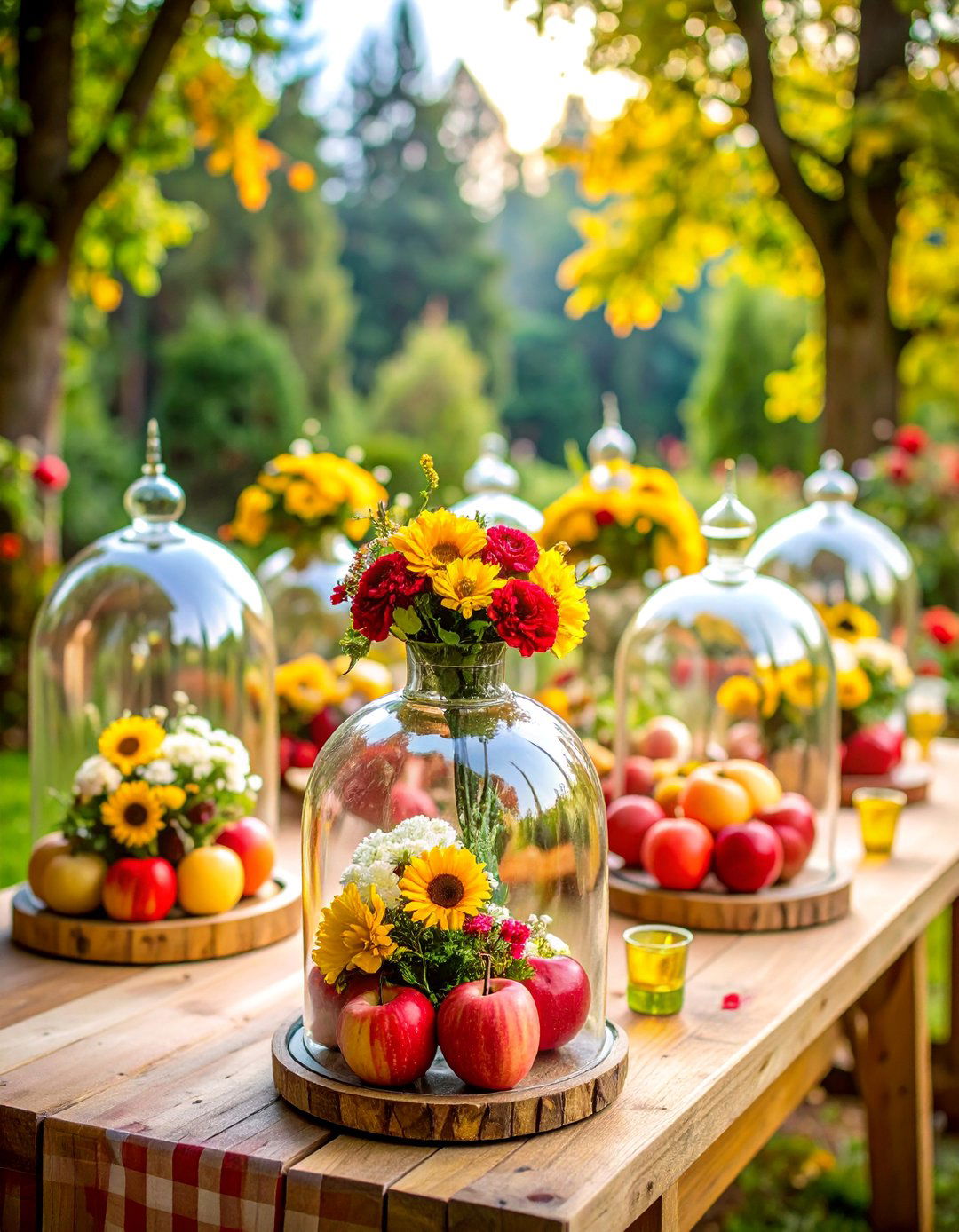
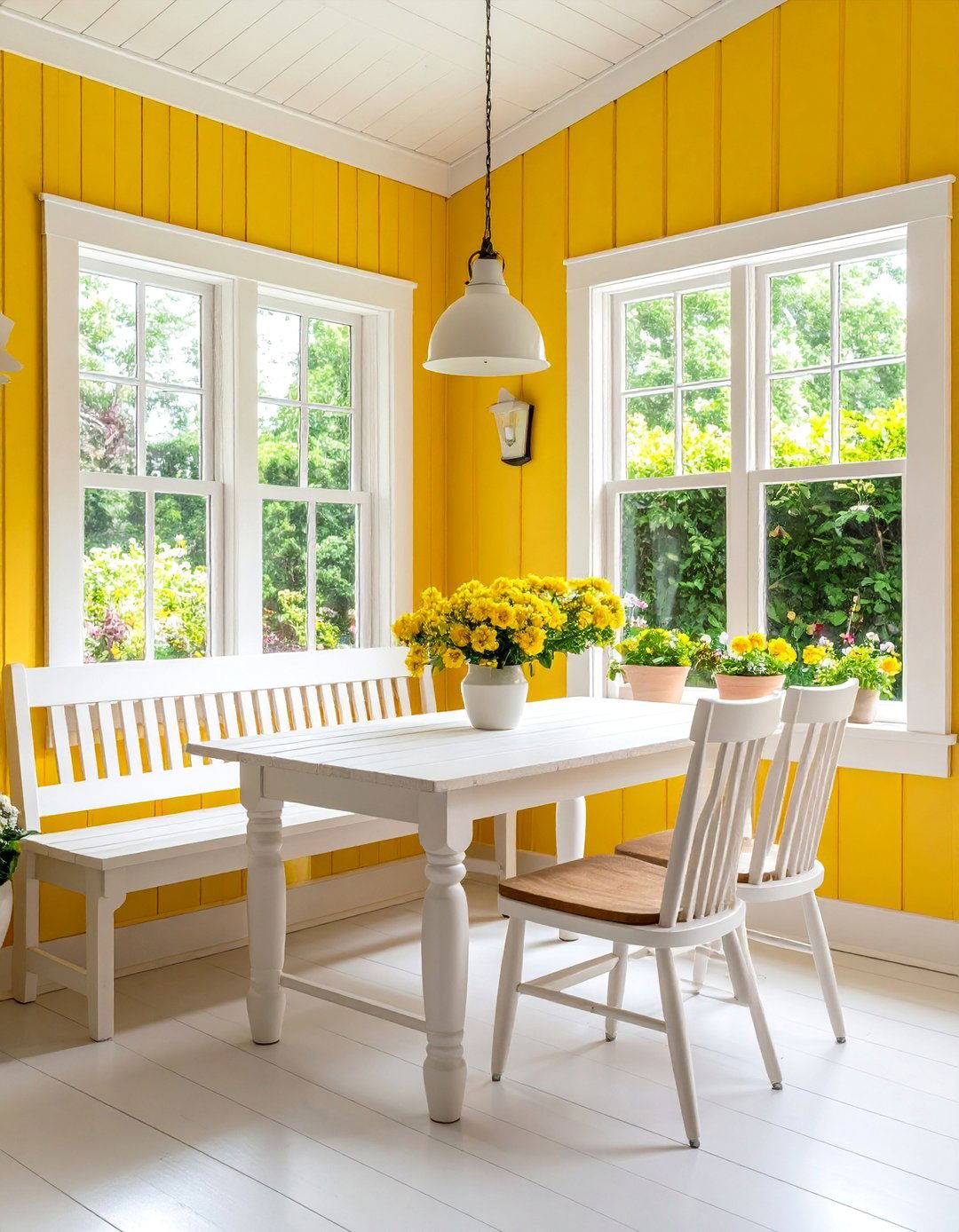
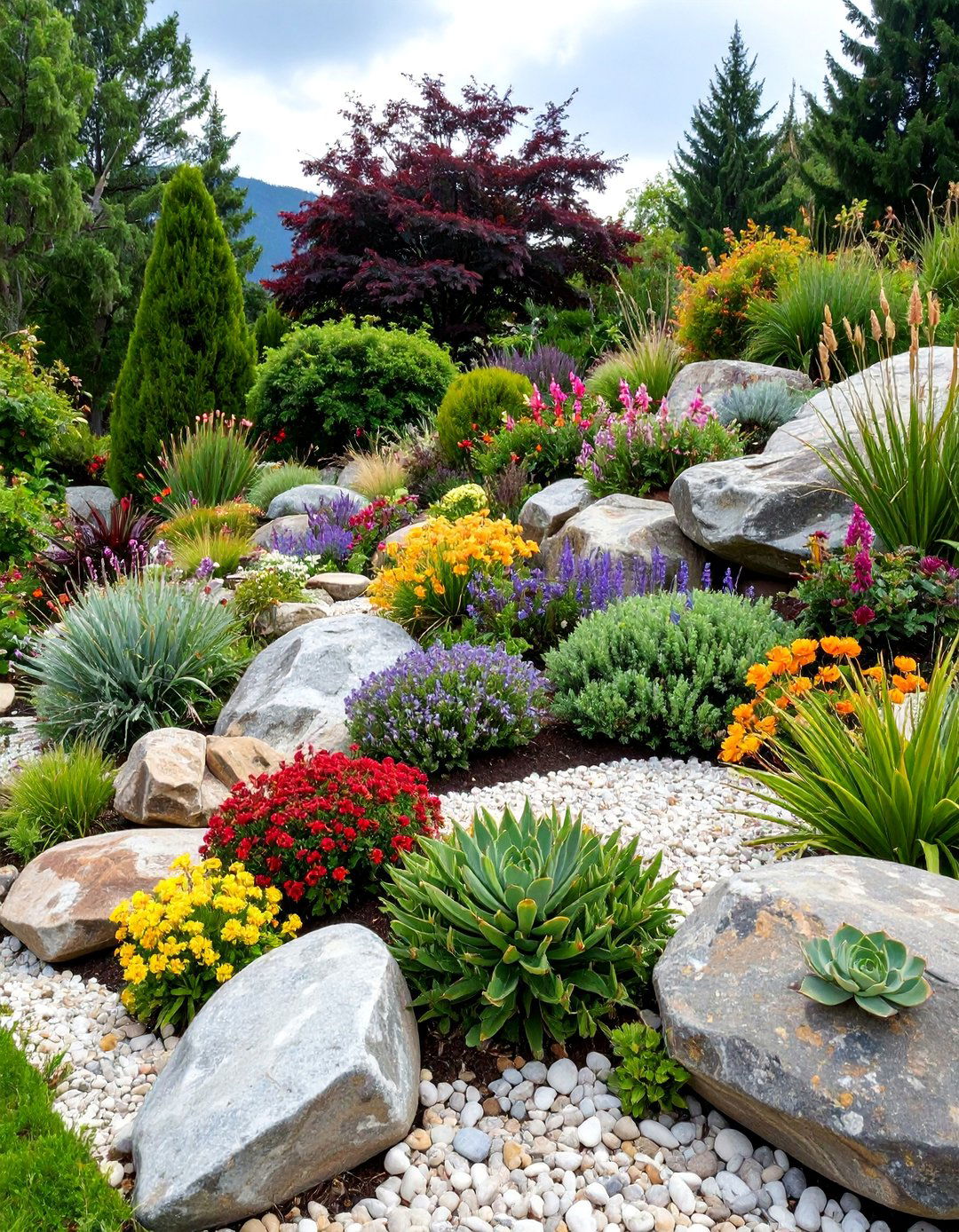

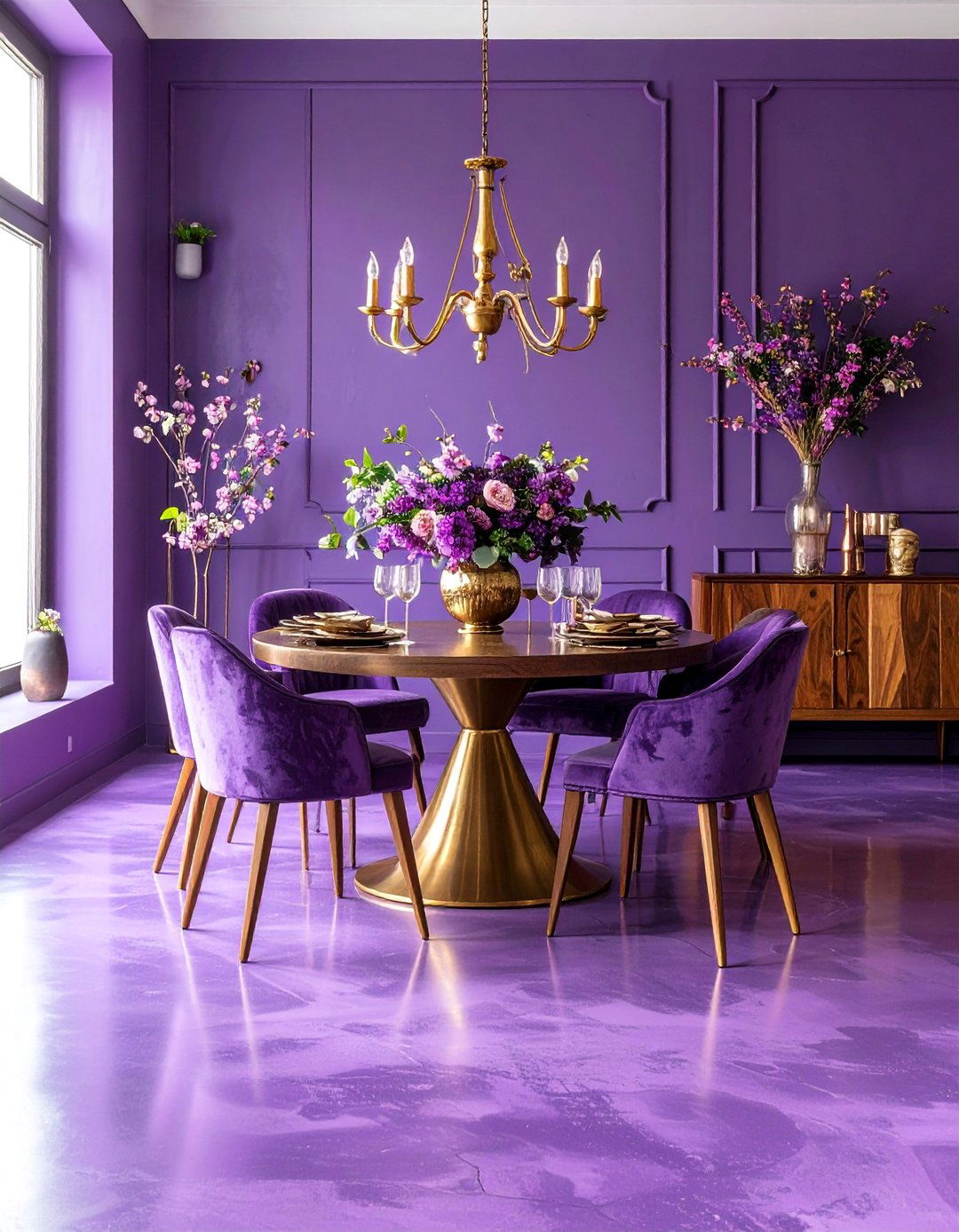


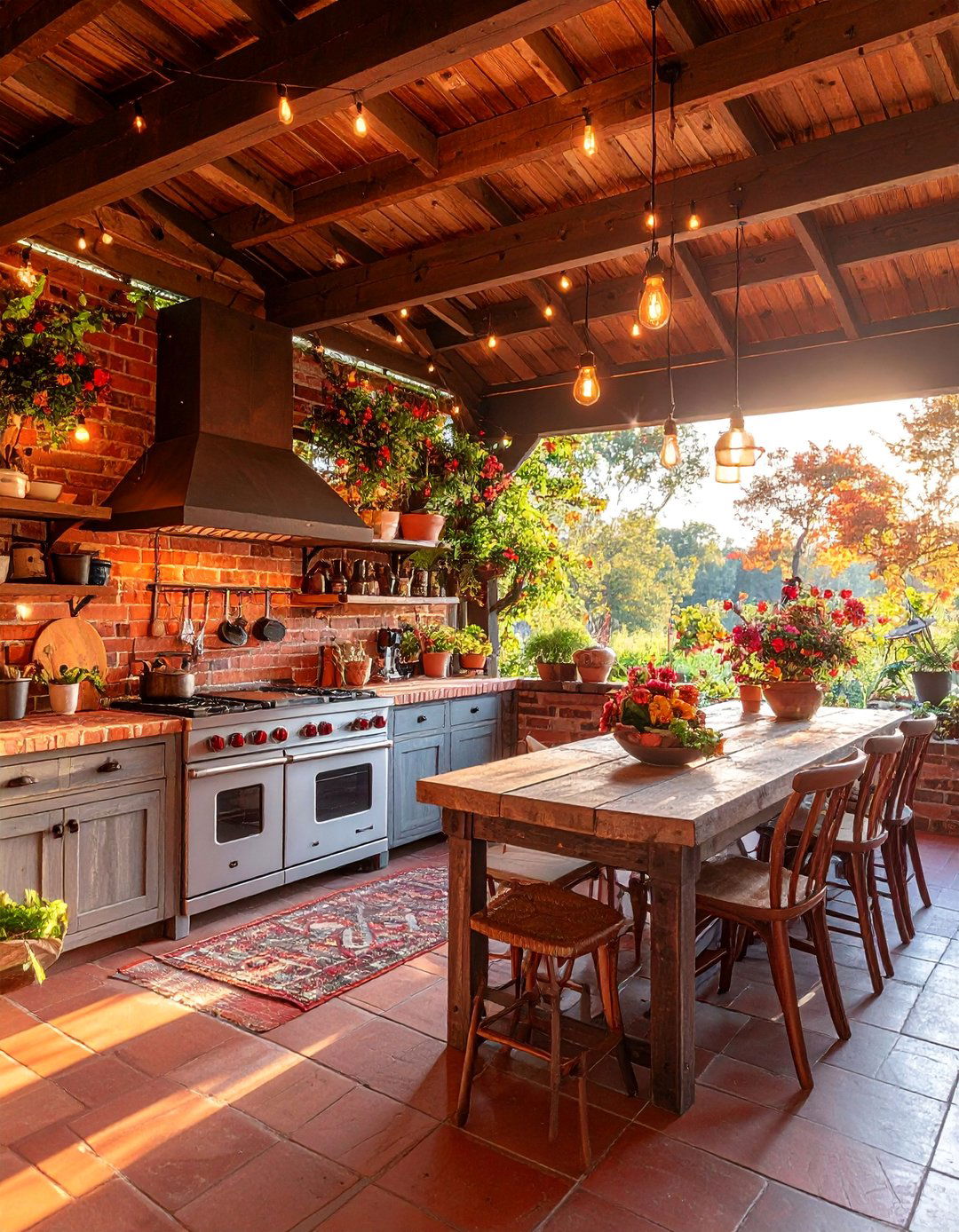
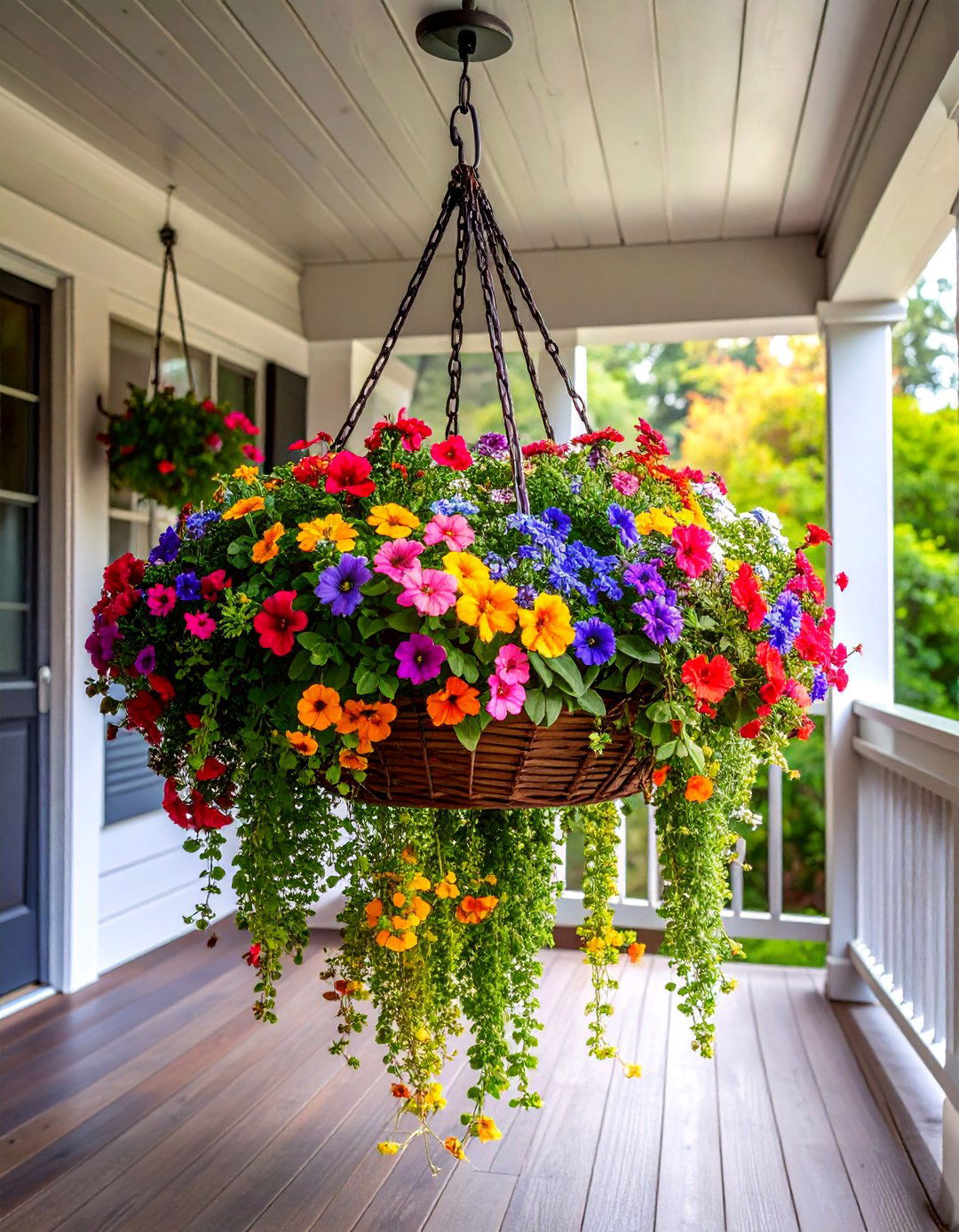
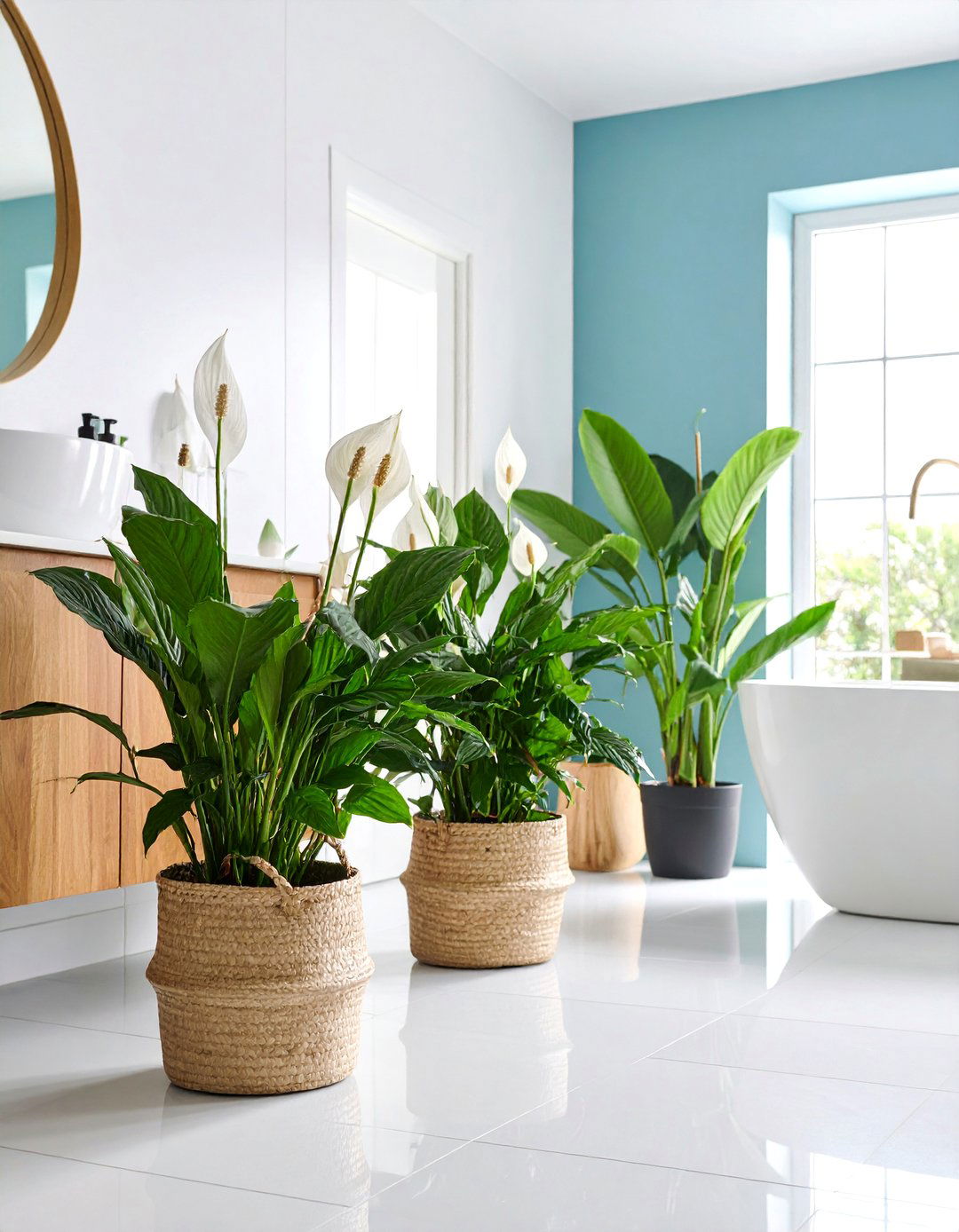

Leave a Reply